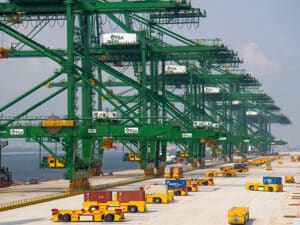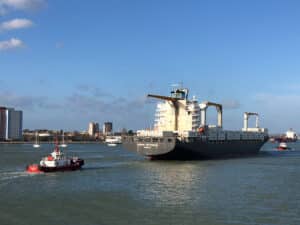
Op-Ed: How technology can help you sail through EEXI and CII and beyond
Written by
Carl Henrickson
by Carl Henrickson, General Manager Shipping & Maritime Technology, Innovation & Digitalization, Shell International Trading and Shipping Company
The year 2021 saw shipping’s total emissions rise by 4.9% year-on-year—not only rebounding to pre-pandemic levels, but in fact surpassing them. Despite a reduction in carbon intensity between 2008 and 2020, current progress cannot keep pace with the growing fleet and demand for shipping. Action to decarbonize must therefore accelerate. The industry cannot delay further, and as a highly visible and hugely important sector, shipping needs to take the lead.
But it can only do so with the right strategy, underpinned by coherent regulation and a willingness to explore and adopt new technologies. This includes: upgrading existing vessels; delivering the most efficient new builds; and leveraging the existing fleet to develop and deploy technologies that unlock a decarbonized future for shipping.
Four regulations shaping shipping’s future
The International Maritime Organization (IMO) has traditionally led the regulatory charge for environmental improvement through the 1973 adoption of the International Convention for the Prevention of Pollution from Ships (MARPOL).
While the MARPOL Convention was originally introduced in response to a series of industry incidents, it has since been updated to reflect an evolving landscape, with industry attention recently turning to more proactive regulations, including:
- Energy Efficiency Design Index (EEDI)—Introduced in 2013, the EEDI set mandatory standards for new ships, requiring a minimum energy efficiency level per capacity mile and thus promoting more energy efficient designs. Following an initial two-year phase, it will be incrementally tightened every five years;
- Ship Energy Efficiency Management Plan (SEEMP)—Introduced in 2011 and strengthened in 2021, the SEEMP is a mandatory document that requires all cargo, RoPax, and cruise vessels above 5,000 gross tonnage, to have an approved plan of how to reach the required carbon intensity indicator (CII) on board, encouraging the sector to consider new solutions for improving ship and fleet efficiency management;
- Energy Efficiency Existing Ship Index (EEXI)—From 2023, the EEXI will address the technical efficiency of ships, introducing new carbon emissions standards to limit the amount of CO2 vessels are allowed to emit; and
- Carbon Intensity Indicator (CII)—In 2023 vessels must also begin calculating their CII rating from actual emissions, based on ship type and size. Rating boundaries will reduce by 2% each year until review in 2026, when the pace may be increased, with ports and authorities encouraged to incentivize higher ratings.
Businesses risk compliance penalties if they fail to reduce their emissions. Fortunately, several options exist to support improvements needed for compliance – which is where technology can help.
A toolbox of technologies
Energy efficient technologies (EET) will play a critical role in the long term, providing sustainable solutions that are preferable to alternatives like slowing steaming, reducing cargo capacity or deviating in order to maintain CII ratings, which could result in breaches to charter party agreements.
In fact, existing EETs could further reduce emissions by up to 25% compared to today’s leading designs. The impact of this could be huge since, according to estimates, an 8% improvement in efficiency will be equivalent to putting 4,400 zero-carbon ships on the water. All operators need to do now is decide which EETs are best suited to their operations and applications.
Rotor sails
By combining a variable speed drive with natural wind power, rotor sails are proven to reduce fuel consumption, emissions and costs by improving a ship’s efficiency. It’s a technology that Shell has implemented in collaboration with Maersk Tankers, ETI and Norsepower, delivering up to 8.2% fuel and emissions savings .
Air lubrication
Air lubrication systems reduce hull friction through the smart distribution of air bubbles into the boundary layer of the hull flat bottom. Again, this is something that Shell has worked on directly, collaborating with Silverstream to deliver a 5-8% reduction in fuel consumption and associated emissions on a Shell-chartered LNGC.
Digital technologies
Various digital technologies are driving operational efficiencies as well. Take voyage optimization: though external variables are unpredictable, this data-driven method combines dynamic programming and algorithms to deliver more economical routing and a potential 5% fuel saving and air emissions reduction.
Meanwhile, draft and trim optimization software—like the Just Add Water System (JAWS) developed by Shell—applies high-frequency data and machine learning to provide real time advice to ensure the hydrodynamic performance of the vessel is optimized at any given speed. JAWS is currently delivering up to 7% emissions reduction and we are working with Kongsberg Maritime to further scale the software and make it available to the industry.
Fuel cells
Fuel cells are considered to be a key enabling technology for future fuels with early development improving energy conversion efficiency to above 60%. This move towards a more efficient means of energy conversion is vital to overcome the challenges associated with the lower energy density of future fuels.
And we do not have to wait to get started, since fuel cell development can happen now using LNG as the primary fuel. A fuel cell can then switch to a zero-carbon fuel in the future, when it becomes available at scale.
LNG
LNG provides a clear route to decarbonization today, reducing emissions by up to 23%. Coupled with technology, the transitional pathway to e-LNG, via bio-LNG in the interim could then extend compliance to 2050 and beyond.
Acting today means impact tomorrow
The purpose of pairing regulation with innovation here is two-fold. Firstly, technologies available today will be critical in helping owners and operators meet compliance initiatives in the short-term. Secondly, these same technologies will support the longer-term unlocking of pathways to net zero, given the energy density challenges of zero-carbon fuels moving forward.
This starts today with LNG, alongside energy efficient technologies that help reduce fuel consumption and associated emissions. But we must continue to invest in R&D to advance the knowledge and experience of the sector; de-risk the enabling technologies; reduce the cost to deploy; and ultimately drive safe, sustainable and commercially viable zero-carbon fuels. It will take strong industry collaboration to achieve this, and we don’t yet have all the answers. One thing is certain, however: progress cannot wait.




